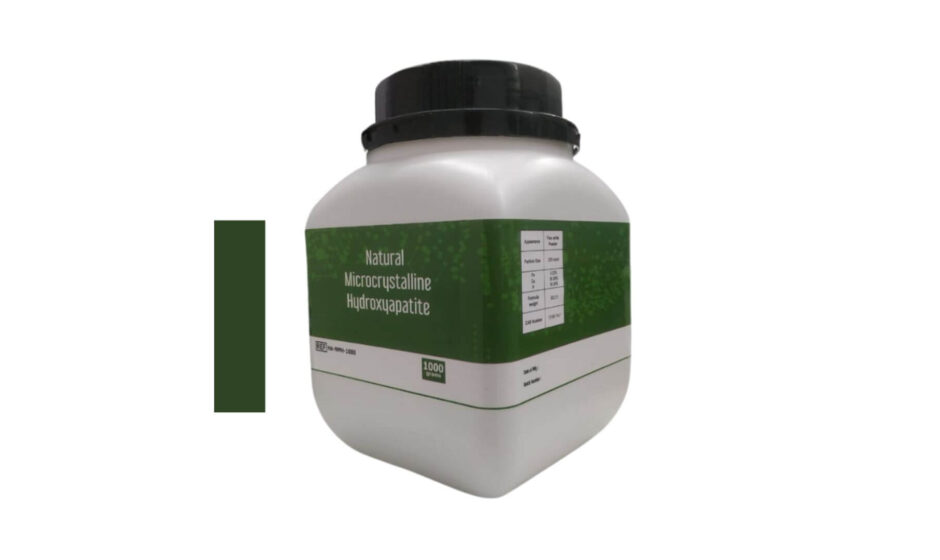In the ever-evolving landscape of nutritional science, bone health, and regenerative medicine, one compound continues to draw growing attention from researchers, healthcare providers, and supplement manufacturers alike—microcrystalline hydroxyapatite (MCHC or MCHA). Derived from the natural mineral form of calcium apatite, MCHC is biologically active, highly absorbable, and closely resembles the mineral composition of human bone and teeth.
Let’s explore why microcrystalline hydroxyapatite matters, not only in the context of skeletal health but also as a cutting-edge solution in modern medicine and holistic wellness.
What Is Microcrystalline Hydroxyapatite?
Microcrystalline hydroxyapatite is a finely milled form of hydroxyapatite (Ca₁₀(PO₄)₆(OH)₂), the naturally occurring mineral that constitutes approximately 60-70% of human bone mass. Unlike synthetic calcium supplements, MCHC is typically extracted from bovine bone and maintains its natural matrix of minerals, collagen, and growth factors.
This bioavailable source of calcium and phosphorus is prized for its ability to mimic the structure and composition of natural bone, facilitating better absorption and integration into the skeletal system.
Superior Bioavailability and Bone Support
Whole Bone Matrix Composition
Unlike isolated calcium supplements such as calcium carbonate or calcium citrate, microcrystalline hydroxyapatite offers a full spectrum of bone nutrients, including:
-
Calcium
-
Phosphorus
-
Collagen (Type I)
-
Trace minerals like magnesium, zinc, and strontium
-
Bone growth factors such as IGF and TGF-β
This composition mirrors human bone and contributes to bone remodeling, density maintenance, and structural integrity over time.
Improved Absorption and Retention
MCHC’s natural crystalline structure allows it to bind effectively to bone surfaces and stimulate osteoblast activity (bone-building cells). Studies have shown that MCHC calcium is more effectively retained in bone tissue, reducing the risk of osteopenia and osteoporosis in aging adults.
Why Microcrystalline Hydroxyapatite Outperforms Traditional Calcium Supplements
| Feature | MCHC (Microcrystalline Hydroxyapatite) | Calcium Carbonate | Calcium Citrate |
|---|---|---|---|
| Calcium Source | Whole bone matrix | Mineral (chalk/rock) | Synthetic |
| Bioavailability | High (natural matrix) | Moderate (with food) | Good (without food) |
| Bone-Building Factors | Yes (collagen, growth factors) | No | No |
| Trace Minerals | Present | Absent | Absent |
| GI Tolerance | Excellent | May cause bloating | Better than carbonate |
| Bone Density Improvement | Clinically supported | Limited support | Limited support |
MCHC is nutritionally superior, providing not just calcium but a synergistic blend of bone-building compounds that traditional calcium supplements lack.
Role in Osteoporosis and Bone Loss Prevention
Clinically Validated Support for Bone Health
Numerous studies have validated MCHC’s effectiveness in slowing or reversing bone loss, especially in postmenopausal women. In a randomized clinical trial, participants supplementing with MCHC experienced increased bone mineral density (BMD) compared to those taking calcium carbonate.
Protection Against Fractures
MCHC may enhance bone microarchitecture, making bones not only denser but also more resilient. This structural benefit is essential in preventing fractures due to falls, aging, or chronic illness such as rheumatoid arthritis or thyroid dysfunction.
Applications in Dentistry and Oral Health
Tooth Remineralization
Because hydroxyapatite is a primary component of dental enamel, MCHC plays a critical role in tooth remineralization. It is now being incorporated into toothpastes, mouthwashes, and dental coatings to:
-
Repair micro-lesions
-
Reduce sensitivity
-
Strengthen enamel
-
Prevent cavities
Implants and Bone Grafts
MCHC is also used as a biocompatible bone graft material in dental and orthopedic procedures. Its osseointegration ability supports the success of implants and reduces healing time after surgeries.
Athletic Performance and Recovery
Bone Stress and Mineral Loss in Athletes
High-impact sports and intense training regimes often result in bone mineral depletion and microfractures. MCHC supplementation helps replenish lost minerals, prevent stress-related injuries, and accelerate recovery in active individuals.
Collagen and Joint Support
The type I collagen in MCHC also supports joint integrity, reducing the risk of injuries and promoting better connective tissue resilience.
Applications in Regenerative Medicine
Scaffold for Tissue Engineering
In regenerative medicine, MCHC is increasingly used as a scaffold material for bone regeneration. Its ability to support cell adhesion and proliferation makes it suitable for:
-
Bone defect reconstruction
-
Spinal fusion
-
Orthopedic prosthetics
Drug Delivery Systems
Researchers are exploring MCHC’s potential as a carrier for targeted drug delivery, especially for anti-inflammatory and anticancer agents, due to its biocompatibility and controlled-release properties.
Safety and Tolerability
Low Risk of Side Effects
Unlike some calcium supplements that may cause constipation, kidney stones, or arterial calcification, MCHC has a low incidence of gastrointestinal discomfort and poses minimal risk for soft tissue calcification, especially when taken in clinically recommended doses.
Sourcing and Purity
High-quality MCHC supplements are typically sourced from grass-fed, antibiotic-free bovine bone, ensuring clean and ethical manufacturing practices. Always verify that products are free of heavy metals and contaminants.
Conclusion: Why Microcrystalline Hydroxyapatite Matters More Than Ever
In an age where personalized wellness and evidence-based supplementation are paramount, microcrystalline hydroxyapatite stands out as a holistic, functional, and effective solution for supporting skeletal, dental, and overall health.
Whether you’re an aging adult looking to preserve bone mass, a recovering athlete, or a dental patient in need of structural restoration, MCHC offers unmatched nutritional and biomedical value that conventional calcium sources simply cannot provide.
It is not just a supplement—it’s the biological blueprint of bone health.



